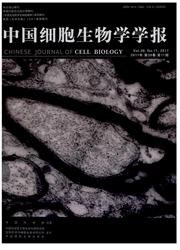

 中文摘要:
中文摘要:
[1]Chen GQ, Zhu J, Shi XG, et al. In vitro studies on cellular andmolecular mechanisms of arsenic trioxide (As2O3) in the treat-ment of acute promyelocytic leukemia: As2O3 induce NB4 cellapoptosis with downregulation of Bcl-2 expression and modula-tion of PML-RARalpha/PML proteins. Blood, 1996; 88:1052- 1061. [2]Chen GQ, Shi XG, Tang W, et al. Use of arsenic trioxide(As2O3) in the treatment of acute promyelocytic leukemia(APL): I .As2O3 exerts dose-dependent dual effects on APLcells. Blood, 1997;89:3345- 3353. [3]Zhu J, Koken MH, Quignon F, et al. Arsenic-induced PMLtargeting onto nuclear bodies: implications for the treatment ofacute promyelocytic leukemia. Proc Natl Acad Sci USA, 1997;94: 3978 - 3983. [4]Zhu J, Shi XG, Chu HY, et al. Effect of retinoic acid isomerson proliferation, differentiation and PML relocation in the APLcell line NB4. Leukemia, 1995;9:302 - 309. [5]Koken MH, Daniel MT, Gianni M, et al. Retinoic acid, butnot arsenic trioxide, degrades the PLZF/RARalpha fusion pro-tein, without inducing terminal differentiation or apoptosis, in aRA-therapy resistant t(11; 17) (q23; q21) APL patient.Oncogene, 1999;18:1113- 1118. [6]Stemsdorf T, Puccetti E, Jensen K, et al. PIC-1/SUMO-1-modified PML-retinoic acid receptor alpha mediates arsenic tri-oxide-induced apoptosis in acute promyelocytic leukemia. MolCell Biol, 1999; 19:5170 - 5178. [7]Wang ZG, Rivi R, Delva L, et al. Arsenic trioxide and melar-soprol induce programmed cell death in myeloid leukemia celllines and function in a PML and PML-RARalpha independentmanner. Blood, 1998 ;92:1497 - 1504. [8]Gianni M, Koken MH, Chelbi-Alix MK, et al. Combined ar-senic and retinoic acid treatment enhances differentiation andapoptosis in arsenic-resistant NB4 cells. Blood, 1998; 91: 4300 -4310.
 同期刊论文项目
同期刊论文项目
 同项目期刊论文
同项目期刊论文
 期刊信息
期刊信息
